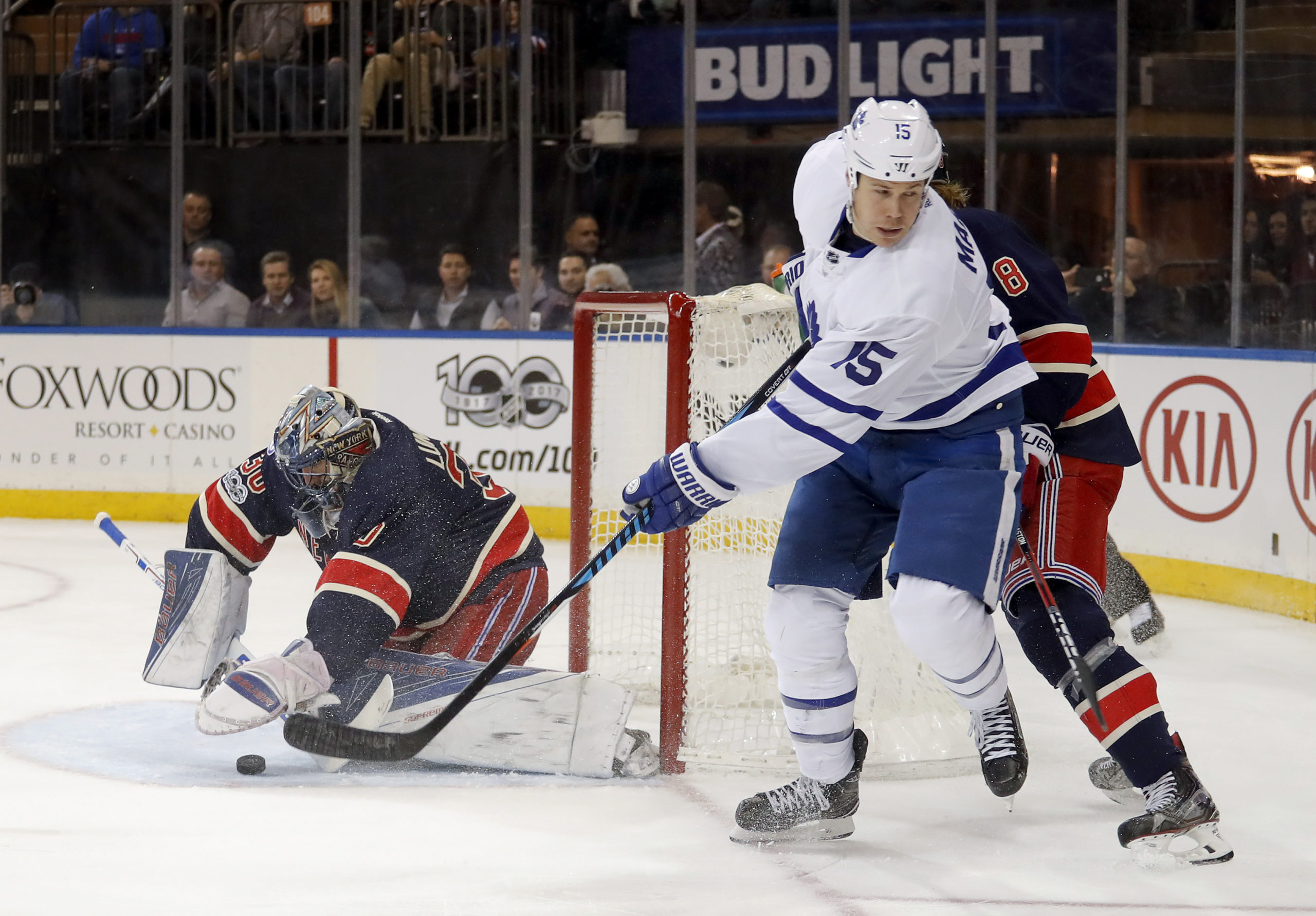Matt Martin, a free agent signing in the 2016 offseason, played his first season with the Maple Leafs in 2016-17.
Signed to a four-year, $2.5 million AAV contract last July 1, the acquisition was unquestionably the most controversial signing of the Lou Lamoriello era to date, and we’re no closer to settling the debate one season later.
2016-17 Season Summary
A 10-goal, 19-point scorer in 2015-16, Martin’s production took a hit this season compared to last (five goals, nine points). That has a lot to do with the fact that he is no longer one-third of one of the more effective fourth lines in the league as he was in New York, where he was a fixture next to Casey Cizikas and Cal Clutterbuck.
Martin was the least skilled player on that line in the first place, and he didn’t play on a very good fourth line in Toronto for much of the 2016-17 season. He played 265 of his 699 even strength minutes alongside center Ben Smith, and the pair produced just two points and a 44.5% CF when on the ice together.
We didn’t see Matt Martin rotate onto a more skilled line at any point or kill penalties (definitely for the best). On average, he only played 8:53 per game, which was nearly two minutes less than he played in his final season in New York. He registered just 66 shots on goal in 82 games compared to 86 in 80 the previous season.
Martin’s season took a turn for the better when the Leafs acquired Brian Boyle at the trade deadline, instantly transforming the team’s fourth line. Martin went from playing 8:46 a game to 9:16 for the rest of the regular season and then up to 9:57 per game in the playoffs. When on the ice with Boyle, Martin was a 51.5% CF in the regular season (170 minutes) and finished fourth among Leafs forwards with a 50% CF in the playoffs.
His best game of the season came in Game 2 against Washington, a two-point effort that included an assist on Kasperi Kapanen’s overtime winner. He also nearly played hero in Game 5 when he rang the crossbar with a nice shot in stride. As a player, Martin isn’t totally irredeemable; he can get up and down the rink well enough to forecheck, he has a hard shot when he gets a chance to use it, and he can extend plays on the cycle. He again led the league in hits per game (3.7) — as he always has since he entered the league in 2010-11 – and that is a positive provided his team has the puck enough when he’s out there.
There is no doubting his 13 fights – fourth in the NHL – is a big part of why he’s in the lineup, which we’ll get into more below.
2016-17 Season Statistics
| GP | G | A | Pts | TOI/g | Shots | Sh% | CF% |
|---|---|---|---|---|---|---|---|
| 82 | 5 | 4 | 9 | 8:53 | 66 | 8.1 | 48.00% |
More interesting than the individual stat line: The Leafs fought a total of 25 times this season – tied for 13th in the NHL – with Martin contributing 13 of those bouts. What’s fascinating about that stat: In the past, Mike Babcock teams have been consistently at the bottom of the league in the fights category.
| Team | Fights | League Rank |
|---|---|---|
| 2016-17 Leafs | 25 | t-13th |
| 2015-16 Leafs | 10 | 28th |
| 2014-15 Wings | 8 | 30th |
| 2013-14 Wings | 7 | 30th |
| 2012-13 Wings | 14 | 29th |
| 2011-12 Wings | 15 | 30th |
| 2010-11 Wings | 11 | 30th |
| 2009-2010 Wings | 19 | 30th |
| 2008-2009 Wings | 11 | 30th |
| 2007-2008 Wings | 21 | 30th |
| 2006-2007 Wings | 10 | 30th |
| 2005-2006 Wings | 6 | 30th |
Perhaps this speaks to Ken Holland’s vs. Lou Lamoriello’s philosophies about the role of fighting in the game; in Anaheim, Babcock’s teams fought a slightly below average amount. It certainly has something to do with team construction as well. In Detroit, Babcock coached veteran teams that he obviously believed weren’t going to be physically intimidated, unlike the rookie-heavy roster in Toronto this season. Babcock likely assessed that the opposition game plan would involve giving the Leafs’ young skilled rookies a rough introduction to the league.
“We don’t get our face washed very much. No one takes advantage of us. It’s pretty nice if you’re a kid and you haven’t had to worry about that one bit. Marty is a real good leader in the room. He does things right. He’s a good pro. It’s a good signing for our team with this many kids on it.”
– Mike Babcock, October 30, 2016
Drawing a few quick examples, Chris Neil was running Leafs players every time he was on the ice in the season opener in Ottawa, and Martin fought Mark Borowiecki that game (it didn’t seem to slow Neil down any). When Jack Dotchin went knee-on-knee with Auston Matthews, Matt Martin fought Braydon Coburn. Did it serve as a deterrent for Dotchin and players like him not to run Matthews in the future? Did Matthews feel safer and looked after? Generally speaking — with Martin on the bench — did the young Leafs feel like they could stand a little taller, as though they had an answer if the game turned rough? These are tough questions to quantify and answer conclusively, but it’s interesting that Babcock underwent a sudden about-face in his philosophy about fighting when faced with coaching such a young team.
Offseason Outlook
The news that the Leafs are bringing back Ben Smith on a one-year contract for expansion draft purposes strongly suggests Martin is going to be among the Leafs’ seven protected forwards.
The Martin signing was never a contract I was a fan of and his first season on the team didn’t change my opinion on it. That said, the Leafs’ intention to protect Martin is far from a surprising development.
The Leafs signed Martin for four years at $2.5 million per season last summer and played him in all 82 games as well as in all six playoff games. Mike Babcock sang his praises repeatedly throughout the season. It is unlikely that they are not going to, a) suddenly now assess that the contract is bad enough to preclude any chance of Vegas claiming it, or b) not care at all if they lose him.
I’d argue there is also a bigger chance than many will acknowledge that Martin could actually be claimed, for a couple of reasons. First of all, Vegas isn’t getting much of an asset off of the Leafs in this expansion draft due to their high number of exemptions. The Leafs are looking at either losing Martin Marincin (with an outside chance it’s Connor Carrick) or one of three waiver-eligible forwards who are in tough to make the team next season in Josh Leivo, Brendan Leipsic or Kerby Rychel. They can protect one of those three forwards, assuming nothing changes between now and the draft and that the Leafs do indeed protect Martin (I’d argue, out of the three, it should be Leivo that gets protected).
The Leafs certainly weren’t the only team willing to offer Martin three or four years and $2+ million in the summer of 2016. Would Vegas want that cap hit for the next three years given cap flexibility is one of their biggest assets in the nascent stage of the franchise’s existence? It’s tough to say, but they weren’t afraid to spend on Vadim Shipachyov, they need to reach the cap floor, and it’s worth noting Martin was a fan favourite on the Island for his physical play and fisticuffs. That might help sell some tickets for an organization that will not be winning many games in its first few seasons — and one that happens to play in the boxing and UFC capital of the world. Watching Martin play the game is no oil painting, but there are not many real fighters remaining in the league that can take a shift and keep up as well as he can. Vegas’ other feasible options among the Leafs’ forwards, as stated, would be AHL players (as of this time) who are waiver eligible.
There is no shortage of fans who would expose Martin and celebrate if the contract was taken off of the Leafs’ hands. But if the organization liked him enough to sign him for four years at $2.5 million, they probably still like him enough to protect him one year later.

































